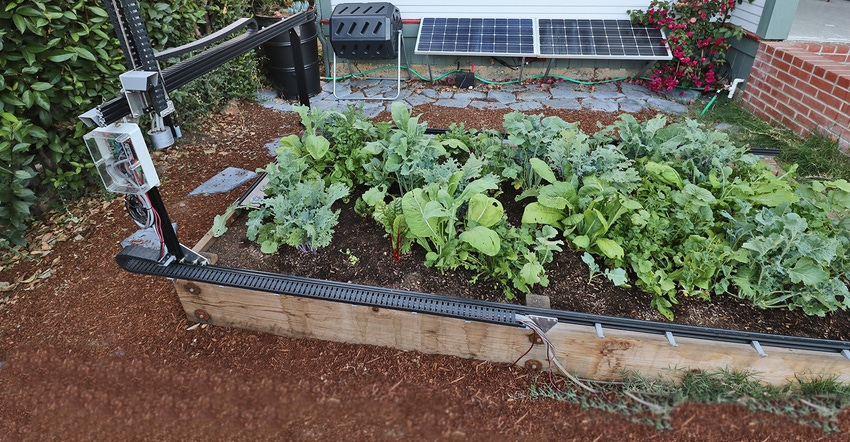
The garden. Even for today’s farm families, finding the time to garden may be harder than ever as everyone is deployed working the farm. Consumers, too, are looking for new sources of fresh food and could find it in their back yard, provided gardening wasn't so time-consuming. A new automated system called FarmBot aims to change the rules for gardeners, and there may be some potential for wider use. too.
The FarmBot system works on a frame over a raised bed that’s 5 feet by 10 feet. The system sits in a frame mounted on the raised bed and can do a wide variety of work. “We have a camera on the FarmBot system that can take pictures of the soil and the [crop] plant to get a precise location for image processing,” says Rory Aronson, founder of the company.
Think of the FarmBot as a “printer head with a mission.” It rides on a track across the garden area, guided by advanced vision systems, to know what’s supposed to be there and what isn’t. The base system is essentially a tool carrier that visits a tool holder to grab the right item to deploy.
Need to spray some insecticide to take out a caterpillar munching on the tomatoes? The system moves to the tool storage location, grabs the spray head and does the job. Got weeds? The system knows where the crop plants are — from that initial photo survey — and it moves in, using a special attachment to essentially punch the weed so it stops growing. Or a gardener can deploy herbicides to stop weeds, too. “The system is versatile,” Aronson says.
Earlier this year, the FarmBot team was awarded a grant from Proto Labs as part of its Cool Idea Award program, which aims to help innovative companies accelerate through the development process.
Aronson likens the FarmBot “head” to a 3-D printer that can do multiple tasks. That tool carrier at one end of the garden space holds everything the bot needs to get the work done.
This high-tech machine uses high-tech manufacturing techniques, including 3-D printing with Proto Labs. “The standard turnaround time is about 12 weeks for these kinds of parts, and that's a long time when you're bringing a product to market,” says Sarah Ekenberg, public relations and marketing, Proto Labs. “With proprietary software we can turn parts in one business day to 15 business days, depending on the part. That’s a lot faster, and can help developers come to market more quickly and affordably.”
For Aronson, the aim was to help people have access to more fresh food with a lot less hassle than the normal gardening experience. He sees the irony of talking about more fresh food in the diet at a time when two-parent, two-career families struggle to have time to put any food on the table — let alone raise their own. And for homes that may have land but are in food deserts, this tech has promise as well.
“The average food eater has no control over the food production process. They want to know how the food is being produced, the practices and the pesticides used,” he says. “This is a way to take control of food production and to bring it to the end consumer.”
Scaling up the tech
The 5- by 10-foot space of the base FarmBot system is great for a smaller home garden, but Aronson notes that larger greenhouses could benefit from this technology, too. In an age when there are labor shortages for this kind of work, the FarmBot could also fill that need.
For example, Aronson notes that for a citrus grower with a large fruit tree operation, there’s one part of the business that involves the tedious process of germinating seeds in little trays. The workers have to pick up the seeds by hand and place them into trays. “And they must be in the correct orientation to get good germination rates,” Aronson explains. “FarmBot could automate that tedious process.”
FarmBot isn’t for row crop farmers, but specialty crop producers may find other ways to deploy such a system in their operations. The system is also popular with educators, who use it to challenge students. Nearly half of FarmBot systems sold today go to educational facilities. In fact, a curriculum for educators and an online hub to help them teach about open-source technology (which FarmBot uses) will soon be online, too.
The technology of raising food is changing. FarmBot is one example showing how automation can be deployed in an innovative way. Check out the video below showing the FarmBot in action.
About the Author(s)
You May Also Like




